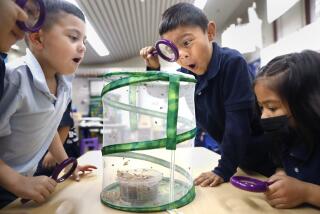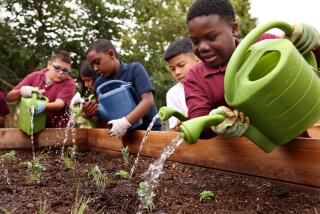Teacher Collaboration on Course
- Share via
It’s the middle of the school day at University Preparation School in Camarillo, but there are no students in Imelda Wagstaff’s colorful classroom.
Instead, the room’s pint-sized tables and chairs are occupied by teachers, who are plotting out the next week’s language arts lessons for their kindergarten and first-grade students.
Their young charges aren’t just roaming campus freely, either. While teachers are brainstorming on classroom strategies and lessons, students are engaged in enrichment activities with specialists -- from art to music to drama.
At the charter school, a kind of laboratory campus for aspiring teachers attending Cal State Channel Islands, they call this Active Collaborating Team time. Educators say the innovative approach, which provides teachers with one hour to meet four days a week, is largely responsible for huge gains on achievement tests made by students in the first eight months of the new school.
“The time for the teachers to collaborate is really important -- it’s probably one of the areas lacking the most in education,” said Linda Ngarupe, the school’s principal. “Here teachers work together to solve problems and implement solutions, and that’s what makes a difference in day-to-day life for students.”
During each of the 12 teacher-training sessions a week -- all three grade levels meet four times -- students rotate through classes in art, physical education, drama and music. The schedule could be implemented at any public school, Ngarupe said, although she said it is easier at a charter school, which is publicly funded but free from many state curriculum restrictions.
University Preparation School serves kindergartners through fifth-graders, who are divided not into single “grade levels” but into age groups: early years (kindergarten and first grade), primary years (second and third grades) and intermediate years (fourth and fifth grades).
More than half of the school’s 350 students come from the surrounding neighborhood, which includes many working-class Latino families, and the rest from schools countywide. This allows the school to run a dual-language immersion program for early-years classes, in which native English and Spanish speakers are taught using both languages.
All classroom teachers are veterans who were chosen from school districts across Ventura County, and they are building the school’s curriculum as they go through the year.
While all lessons are based on state standards -- a checklist of facts and skills all students are supposed to master each year -- teachers don’t use state-issued textbooks or lesson plans. And they try to integrate themes into lessons on many subjects.
For example, during the teacher meeting in Wagstaff’s classroom last week, early-years teachers planned a lesson using an oversized book called “Margaret and Margarita,” which is written in English and Spanish.
Using the book through the week, students will read the story and study vocabulary words (language arts), compare how the two characters are culturally alike and different (social studies) and paint a picture of themselves and a friend (art).
Different teachers take on the lesson plans in each subject, and then share them with the entire group.
“We take these plans and mold them to fit our own kids’ needs,” said Charmon Evans, an early-years teacher. “It just makes it a little easier, because you know these lessons have been investigated thoroughly.”
Cindy Gray, who teaches an intermediate-years class, said being involved in the process has taught her more about curriculum in one year at University Preparation School than she learned in 14 years as an elementary school teacher.
“It’s exhausting -- it feels like my first year of teaching,” said Gray, one of more than a dozen teachers participating in the program. “When you teach the same thing every year, you had your routine, and you weren’t forced to grow.”
Although most students don’t realize what their teachers are doing while they are enjoying art and drama classes, many said they appreciate the time away from a traditional classroom setting.
One day last week, a group of students ran track while another performed in a musical concert and another studied the work of artist Faith Ringgold.
“We do a lot of fun things here,” said 10-year-old Cynthia Valles, who was creating her own story-quilt picture in the image of one by Ringgold that was hanging in the front of the class. “You don’t have to sit in the same desk all day, you have different teachers and you get to learn different stuff.”
More to Read
Sign up for Essential California
The most important California stories and recommendations in your inbox every morning.
You may occasionally receive promotional content from the Los Angeles Times.










